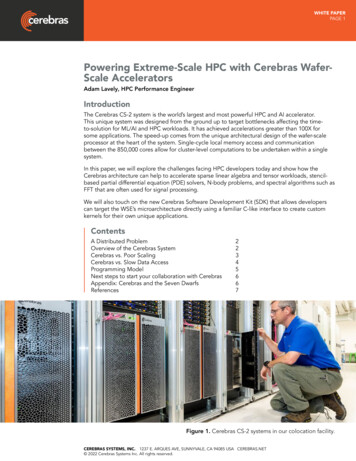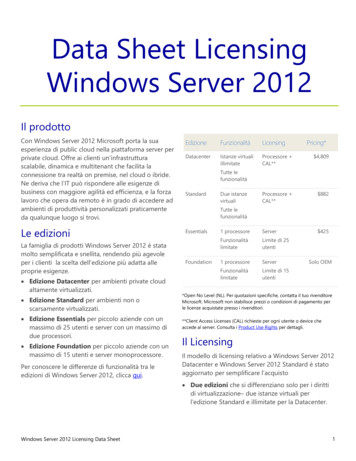
Transcription
CreatingWorld ChangingTechnologiesAccelerating thePossibilities with HPCTrish DamkrogerVice President and General Manager, High Performance Computing
Ma n u fa c t u rin gHPC is Evolving,Expanding andEverywhereMore use cases More data More users New requirementsW e a t h e r P re d ic t io nC h e m ic a l S c ie n c e sRe s e rvo ir S im u la t io nYo u r Us e C a s e He re
Intel HPC PortfolioXPU ArchitecturesSoftware ToolsMemoryCompute AccelerationoneAPI HPC & AI Analytics ToolkitOptane Persistent MemoryStorageInterconnectSecurity Optane SSDs DAOS Ethernet Fabric support Crypto Acceleration Intel SGX
Intel HPC PortfolioXPU ArchitecturesCompute AccelerationSoftware ToolsoneAPI HPC & AI Analytics ToolkitMemoryOptane Persistent MemoryNEWNEWDAOS Commercial SupportStorage Optane SSDs DAOSHigh Performance NetworkingInterconnect Ethernet Fabric supportSecurity Crypto Acceleration Intel SGX
6TBUp toUp to3rd Gen Intel Xeon Scalable processorsUp toSystem Memory Capacity(Per Socket) DRAM PMEMper processor8CH20%IPC improvementISO Freq, ISO compilerDDR4-32002 DPC (Per Socket)Advanced security solutionsIntel SoftwareGuard ExtensionsIntelCryptoAccelerationIntel TotalMemoryEncryption40 CoresIntel PlatformFirmwareResilience53%Increase for HPCworkloads**See [108] at www.intel.com/3gen-xeon-config. Results may vary. See backup for configuration details.Scalable, flexible, customizableIntel Speed SelectIntel DeepTechnologyLearning BoostIntelAVX-512OptimizedSoftware
Competitive Leadership3rd Gen Intel Xeon Scalable processor vs. AMD EPYC MilanSuperior performance at equal cores (32)Monte Carlo3rd gen Xeon vsEPYC MilanUp to23%Better performanceacross 12 leading HPCapplications andbenchmarksUp toRELION105%better performanceUp to68%better performanceNAMDUp toLAMMPS62%better performance57%better performanceBinomial OptionsUp to37%better performanceMainstream SKUs: Intel Xeon 8358 vs EPYC Milan 7543See backup for configuration details. Results may varyUp to
*Performance varies by use, configuration and other factors. See [52] at www.intel.com/3gen-xeon-config.
*Performance varies by use, configuration and other factors. See [56] at www.intel.com/3gen-xeon-config.
Welcoming Ice Lake customers and partners3rd Gen Intel Xeon Scalable processor momentum
Xe Architecture: Brought to LifePowered On & In ValidationIn Intel DevCloudDG2 SamplingShipping11th Gen CoreProcessorShippingIris Xe MAXShipping
Freedom for Accelerated ComputeBreak Free from the Constraints of Proprietary Programming ModelsFreedom of Choice in HardwareMulti-Vendor Adoption Momentum Codeplay brings SYCL support for NVIDIA GPUsFujitsu Fugaku uses oneAPI oneDNN on ArmHuawei AI Chipset supported by Data Parallel C NERSC, ALCF, Codeplay partner on SYCL for next gen SupercomputerRealize All the Hardware Value on XPUsOptimized Libraries, Compilers, AnalysisTools &Intel DevCloudConfidently Develop Performant CodeCompatible with Existing Languages & StandardsIntel oneAPI Toolkits for HPC, AI, Rendering CPUGPUFPGA
"We see Intel as a vital long-term partner atCambridge, investing in our communitythrough systems development, training, andaccess to new and emerging technologies.[At] the Cambridge Open Exascale Lab. userscan access our 10 petaflop system to developcode for Intel GPUs using oneAPI and get helpoptimizing applications for both CPUs andaccelerators. They can also investigate intoextreme scale storage systems like Intel DAOSand work with cutting-edge high-performanceEthernet fabrics."Dr. Paul CallejaDirector of Research Computing ServicesUniversity of Cambridge
"Intel is providing the blended environment weneed, with next-generation Intel Xeon Scalableprocessors (Sapphire Rapids), with built-inacceleration for new HPC and AI workloads—plus Ponte Vecchio, Intel's upcoming GPU.Since our users need to access data as quicklyas possible, we'll be using Intel DAOS for fast,high bandwidth, low latency, and high IOPSstorage, on a system with 3rd Gen Xeonprocessors and Optane persistent memory."Prof. Dieter KranzlmüllerChairman of the Board of Directors of theLeibniz Supercomputing Centre (LRZ)
Intel Xeon Scalable ProcessorThe ONLY x86 Datacenter CPU with Built-in AI AccelerationIntel Advanced Vector Extensions 512Intel Deep Learning BoostIntel Optane persistent memoryCascade Lake14nmNew AI acceleration built-in(Intel DL Boost with VNNI)New memory storage hierarchyIce Lake10nmNew microarchitectureIncreased memory bandwidthSapphire Rapids10nm Enhanced SuperFinNext gen Intel DL Boost(Intel Advanced Matrix Extensions)Accelerating Innovationfrom Edge to Cloud to Supercomputing
Next-Generation Intel Xeon Scalable ProcessorsUnique Capabilities Optimized for HPC and AI Acceleration
Next-Generation Intel Xeon Scalable ProcessorsUnique Capabilities Optimized for HPC and AI AccelerationBreakthrough TechnologyDDR5Increased Memory BWPCIE 5High ThroughputCXL 1.1Next-gen IO
Next-Generation Intel Xeon Scalable ProcessorsUnique Capabilities Optimized for HPC and AI AccelerationBreakthrough TechnologyDDR5Increased Memory BWPCIE 5High ThroughputCXL 1.1Next-gen IOBuilt-In AI AccelerationIntel Advanced Matrix Extensions (AMX)Increased Deep Learning Inference and Training Performance
Next-Generation Intel Xeon Scalable ProcessorsUnique Capabilities Optimized for HPC and AI AccelerationBreakthrough TechnologyDDR5Increased Memory BWPCIE 5High ThroughputCXL 1.1Next-gen IOBuilt-In AI AccelerationIntel Advanced Matrix Extensions (AMX)Increased Deep Learning Inference and Training PerformanceAgility and ScalabilityHardwareEnhanced SecurityIntel Speed SelectTechnologyBroadSoftware Optimization
Next-Generation Intel Xeon Scalable ProcessorsUnique Capabilities Optimized for HPC and AI AccelerationBreakthrough TechnologyDDR5Increased Memory BWPCIE 5High ThroughputCXL 1.1Next-gen IOBuilt-In AI AccelerationIntel Advanced Matrix Extensions (AMX)Increased Deep Learning Inference and Training PerformanceAgility and ScalabilityHardwareEnhanced SecurityNEWIntel Speed SelectTechnologyBroadSoftware OptimizationHigh Bandwidth MemorySignificant performance increase forbandwidth-bound workloads
Accelerating HPC for the FutureIntel Xeon processorsremain the foundation ofHPC & AI
Accelerating HPC for the FutureIntel Xeon processorsremain the foundation ofHPC & AIIntel deliversheterogeneousarchitectures for today's &tomorrow’s challenges
Accelerating HPC for the FutureIntel Xeon processorsremain the foundation ofHPC & AIIntel deliversheterogeneousarchitectures for today's &tomorrow’s challengesIntel's HPC portfolio hasthe flexibility to grow withchanging customerdemands
Intel @ ISC’21Visit the Intel HPC AI Pavilion @ www.hpcevents.intel.comFireside ChatsTechnical TalksPurpose-Built AI Accelerators Deployment for High Performance ComputingHPC Productivity Increase with Hybrid HPCaaSHPC in the Cloud: Extending the Reach and Impact of HPC for EveryoneXPU Support for the NAMD Molecular Dynamics Application with oneAPIStandards Driven Heterogenous Programming with oneAPIMigrating and Tuning a CUDA-Based Stencil Computation to DPC Cornelis Networks Omni-Path Express (OPX) Technology: Purpose Built,High Performance Fabrics in a Converged HPC/AI WorldUtilizing the oneAPI Rendering Toolkit to Enhance Scientific DiscoveryIntel and Google on Bringing DAOS to the CloudCXL Fireside ChatFireside Chat Intel System Server D50TNP for HPCA Look Inside the Powerful HPC Partnership Between HPE and Intel and Howthe Joint Solutions Overcome Computing Challenges of Today’s Digital WorldConsiderations for HPC and AI in the CloudLeadership in Uncertain Times: Observations & Learnings from IndustryLeadersIce Lake, Together with Mellanox Interconnect Solutions, Deliver Best in ClassPerformance for HPC ApplicationsOptimizing a Memory-Intensive Simulation Code for Heterogenous OptaneMemory SystemsIntel Quantum Computing: An Example of Workload-Driven System DesignBest Practices in Selection of the Latest Intel Technologies for HPC-EnabledSimulationsAccelerating Derivative Valuations Using AI and AVX-512Atos to Address Exascale Challenges by Leveraging oneAPI Industry Standardto Get Ready for Intel’s Future GPUs and Next Gen Xeon Scalable ProcessorsA Partnership for Future HPC Technologies ExplorationAccelerate High Performance Computing on the Cloud
Configuration Details: Intel Xeon 8358 vs AMD EPYC 7543(slide 1 of 2)HPCG: Platinum 8358: 1-node, 2x Intel Xeon Platinum 8358 (32C/2.6GHz, 250W TDP) processor on Intel Software Development Platform with 256 GB (16 slots/ 16GB/ 3200) total DDR4 memory, ucode 0x261, HT on, Turboon, CentOS Linux 8.3.2011, 4.18.0-240.1.1.el8 3.crt1.x86 64, 1x Intel SSDSC2KG96, App Version: 2019u5 MKL; Build notes: Tools: Intel MKL 2020u4, Intel C Compiler 2020u4, Intel MPI 2019u8; threads/core: 1; Turbo: used; Buildknobs: -O3 -ip -xCORE-AVX512. EPYC 7543: 1-node, 2-socket AMD EPYC 7543 (32C/2.8GHz, 240W cTDP) on Dell PowerEdge R7525 server with 1024 GB (16 slots/ 64GB/3200) total DDR4 memory, ucode 0xa001119, SMTon, Boost on, Power deterministic mode, NPS 4, Red Hat Enterprise Linux 8.3, 4.18, 2x Micron 5300 Pro, App Version: 2019u5 MKL; Build notes: Tools: Intel MKL 2020u4, Intel C Compiler 2020u4, Intel MPI 2019u8; threads/core:1; Turbo: used; Build knobs: -O3 -ip -march core-avx2, tested by Intel and results as of April 2021HPL: Platinum 8358: 1-node, 2x Intel Xeon Platinum 8358 (32C/2.6GHz, 250W TDP) processor on Intel Software Development Platform with 256 GB (16 slots/ 16GB/ 3200) total DDR4 memory, ucode 0x261, HT on, Turbo on,CentOS Linux 8.3.2011, 4.18.0-240.1.1.el8 3.crt1.x86 64, 1x Intel SSDSC2KG96, App Version: The Intel Distribution for LINPACK Benchmark; Build notes: Tools: Intel MPI 2019u7; threads/core: 1; Turbo: used; Build: build scriptfrom Intel Distribution for LINPACK package; 1 rank per NUMA node: 1 rank per socket, EPYC 7543: 1-node, 2-socket AMD EPYC 7543 (32C/2.8GHz, 240W cTDP) on Dell PowerEdge R7525 server with 1024 GB (16 slots/64GB/3200) total DDR4 memory, ucode 0xa001119, SMT on, Boost on, Power deterministic mode, NPS 4, Red Hat Enterprise Linux 8.3, 4.18, 2x Micron 5300 Pro, App Version: AMD official HPL 2.3 MT version with BLIS 2.1;Build notes: Tools: hpc-x 2.7.0; threads/core: 1; Turbo: used; Build: pre-built binary (gcc built) from https://developer.amd.com/amd-aocl/blas-library/; 1 rank per L3 cache, 4 threads per rank, tested by Intel and results as of April2021Stream Triad: Platinum 8358: 1-node, 2x Intel Xeon Platinum 8358 (32C/2.6GHz, 250W TDP) processor on Intel Software Development Platform with 256 GB (16 slots/ 16GB/ 3200) total DDR4 memory, ucode 0x261, HT on,Turbo on, CentOS Linux 8.3.2011, 4.18.0-240.1.1.el8 3.crt1.x86 64, 1x Intel SSDSC2KG96, App Version: McCalpin STREAM OMP-version; Build notes: Tools: Intel C Compiler 2019u5; threads/core: 1; Turbo: used; BIOS settings:HT on Turbo On SNC On. EPYC 7543: 1-node, 2-socket AMD EPYC 7543 (32C/2.8GHz, 240W cTDP) on Dell PowerEdge R7525 server with 1024 GB (16 slots/ 64GB/3200) total DDR4 memory, ucode 0xa001119, SMT on,Boost on, Power deterministic mode, NPS 4, Red Hat Enterprise Linux 8.3, 4.18, 2x Micron 5300 Pro, App Version: McCalpin STREAM OMP-version; Build notes: Tools: Intel C Compiler 2019u5; threads/core: 1; Turbo: used;BIOS settings: HT on Turbo On SNC On, tested by Intel and results as of April 2021WRF Geomean of Conus-12km, Conus-2.5km, NWSC-3 NA-3km: Platinum 8358: 1-node 2x Intel Xeon Platinum 8358 (32C/2.6GHz, 250W TDP) processor on Intel Software Development Platform with 256 GB (16 slots/ 16GB/3200) total DDR4 memory, ucode 0x261, HT on, Turbo on, CentOS Linux 8.3.2011, 4.18.0-240.1.1.el8 3.crt1.x86 64, 1x Intel SSDSC2KG96, App Version: 4.2.2; Build notes: Intel Fortran Compiler 2020u4, Intel MPI 2020u4;threads/core: 1; Turbo: used; Build knobs:-ip -w -O3 -xCORE-AVX2 -vec-threshold0 -ftz -align array64byte -qno-opt-dynamic-align -fno-alias (FORMAT FREE) (BYTESWAPIO) -fp-model fast 2 -fimf-use-svml true -inlinemax-size 12000 -inline-max-total-size 30000. EPYC 7763: 1-node, 2-socket AMD EPYC 7543: 1-node, 2-socket AMD EPYC 7543 (32C/2.8GHz, 240W cTDP) on Dell PowerEdge R7525 server with 1024 GB (16 slots/64GB/3200) total DDR4 memory, ucode 0xa001119, SMT on, Boost on, Power deterministic mode, NPS 4, Red Hat Enterprise Linux 8.3, 4.18, 2x Micron 5300 Pro, App Version: 4.2.2; Build notes: Intel Fortran Compiler 2020u4,Intel MPI 2020u4; threads/core: 1; Turbo: used; Build knobs: -ip -w -O3 -march core-avx2 -ftz -align all -fno-alias (FORMAT FREE) (BYTESWAPIO) -fp-model fast 2 -inline-max-size 12000 -inline-max-total-size 30000,tested by Intel and results as of April 2021Binomial Options: Platinum 8358: 1-node, 2x Intel Xeon Platinum 8358 (32C/2.6GHz, 250W TDP) processor on Intel Software Development Platform with 256 GB (16 slots/ 16GB/ 3200) total DDR4 memory, ucode 0x261, HTon, Turbo on, CentOS Linux 8.3.2011, 4.18.0-240.1.1.el8 3.crt1.x86 64, 1x Intel SSDSC2KG96, App Version: v1.0; Build notes: Tools: Intel C Compiler 2020u4, Intel Threading Building Blocks ; threads/core: 2; Turbo: used; Buildknobs: -O3 -xCORE-AVX512 -qopt-zmm-usage high -fimf-domain-exclusion 31 -fimf-accuracy-bits 11 -no-prec-div -no-prec-sqrt EPYC 7543: 1-node, 2-socket AMD EPYC 7543 (32C/2.8GHz, 240W cTDP) on Dell PowerEdgeR7525 server with 1024 GB (16 slots/ 64GB/3200) total DDR4 memory, ucode 0xa001119, SMT on, Boost on, Power deterministic mode, NPS 4, Red Hat Enterprise Linux 8.3, 4.18, 2x Micron 5300 Pro, App Version: v1.0; Buildnotes: Tools: Intel C Compiler 2020u4, Intel Threading Building Blocks ; threads/core: 2; Turbo: used; Build knobs: -O3 -march core-avx2 -fimf-domain-exclusion 31 -fimf-accuracy-bits 11 -no-prec-div -no-prec-sqrt, tested by Inteland results as of April 2021Monte Carlo: Platinum 8358: 1-node, 2x Intel Xeon Platinum 8358 (32C/2.6GHz, 250W TDP) processor on Intel Software Development Platform with 256 GB (16 slots/ 16GB/ 3200) total DDR4 memory, ucode 0x261, HT on,Turbo on, CentOS Linux 8.3.2011, 4.18.0-240.1.1.el8 3.crt1.x86 64, 1x Intel SSDSC2KG96, App Version: v1.1; Build notes: Tools: Intel MKL 2020u4, Intel C Compiler 2020u4, Intel Threading Building Blocks 2020u4; threads/core:1; Turbo: used; Build knobs: -O3 -xCORE-AVX512 -qopt-zmm-usage high -fimf-precision low -fimf-domain-exclusion 31 -no-prec-div -no-prec-sqrt. EPYC 7543: 1-node, 2-socket AMD EPYC 7543 (32C/2.8GHz, 240W cTDP)on Dell PowerEdge R7525 server with 1024 GB (16 slots/ 64GB/3200) total DDR4 memory, ucode 0xa001119, SMT on, Boost on, Power deterministic mode, NPS 4, Red Hat Enterprise Linux 8.3, 4.18, 2x Micron 5300 Pro, AppVersion: v1.1; Build notes: Tools: Intel MKL 2020u4, Intel C Compiler 2020u4, Intel Threading Building Blocks 2020u4; threads/core: 2; Turbo: used; Build knobs: -O3 -march core-avx2 -fimf-precision low -fimf-domainexclusion 31 -no-prec-div -no-prec-sqrt, tested by Intel and results as of April 2021
Configuration Details: Intel Xeon 8358 vs AMD EPYC 7543(slide 2 of 2)Ansys Fluent Geomean of aircraft wing 14m, aircraft wing 2m, combustor 12m, combustor 16m, combustor 71m, exhaust system 33m, fluidized bed 2m, ice 2m, landing gear 15m, oil rig 7m, pump 2m, rotor 3m,sedan 4m: Platinum 8358: 1-node, 2x Intel Xeon Platinum 8358 (32C/2.6GHz, 250W TDP) processor on Intel Software Development Platform with 256 GB (16 slots/ 16GB/ 3200) total DDR4 memory, ucode 0x261, HT on,Turbo on, CentOS Linux 8.3.2011, 4.18.0-240.1.1.el8 3.crt1.x86 64, 1x Intel SSDSC2KG96, App Version: 2021 R1; Build notes: One thread per core; Multi-threading Enabled; Turbo Boost Enabled; Intel FORTRAN Compiler 19.5.0;Intel C/C Compiler 19.5.0; Intel Math Kernel Library 2020.0.0; Intel MPI Library 2019 Update 8, EPYC 7543: 1-node, 2-socket AMD EPYC 7543 (32C/2.8GHz, 240W cTDP) on Dell PowerEdge R7525 server with 1024 GB (16slots/ 64GB/3200) total DDR4 memory, ucode 0xa001119, SMT on, Boost on, Power deterministic mode, NPS 4, Red Hat Enterprise Linux 8.3, 4.18, 2x Micron 5300 Pro, App Version: 2021 R1; Build notes: One thread per core;Multi-threading Enabled; Turbo Boost Enabled; Intel FORTRAN Compiler 19.5.0; Intel C/C Compiler 19.5.0; Intel Math Kernel Library 2020.0.0; Intel MPI Library 2019 Update 8, tested by Intel and results as of April 2021Ansys LS-DYNA Geomean of car2car-120ms, ODB 10M-30ms: Platinum 8358: 1-node, 2x Intel Xeon Platinum 8358 (32C/2.6GHz, 250W TDP) processor on Intel Software Development Platform with 256 GB (16 slots/ 16GB/3200) total DDR4 memory, ucode 0x261, HT on, Turbo on, CentOS Linux 8.3.2011, 4.18.0-240.1.1.el8 3.crt1.x86 64, 1x Intel SSDSC2KG96, App Version: R11; Build notes: Tools: Intel Compiler 2019u5 (AVX512), Intel MPI 2019u9;threads/core: 1; Turbo: used, EPYC 7543: 1-node, 2-socket AMD EPYC 7543 (32C/2.8GHz, 240W cTDP) on Dell PowerEdge R7525 server with 1024 GB (16 slots/ 64GB/3200) total DDR4 memory, ucode 0xa001119, SMT on,Boost on, Power deterministic mode, NPS 4, Red Hat Enterprise Linux 8.3, 4.18, 2x Micron 5300 Pro, App Version: R11; Build notes: Tools: Intel Compiler 2019u5 (AMDAVX2), Intel MPI 2019u9; threads/core: 1; Turbo: used, testedby Intel and results as of April 2021OpenFOAM 42M cell motorbike: Platinum 8358: 1-node, 2x Intel Xeon Platinum 8358 (32C/2.6GHz, 250W TDP) processor on Intel Software Development Platform with 256 GB (16 slots/ 16GB/ 3200) total DDR4 memory,ucode 0x261, HT on, Turbo on, CentOS Linux 8.3.2011, 4.18.0-240.1.1.el8 3.crt1.x86 64, 1x Intel SSDSC2KG96, App Version: v8; Build notes: Tools: Intel FORTRAN Compiler 2020u4, Intel C Compiler 2020u4, Intel MPI 2019u8;threads/core: 1; Turbo: used; Build knobs: -O3 -ip -xCORE-AVX512. EPYC 7543: 1-node, 2-socket AMD EPYC 7543 (32C/2.8GHz, 240W cTDP) on Dell PowerEdge R7525 server with 1024 GB (16 slots/ 64GB/3200) totalDDR4 memory, ucode 0xa001119, SMT on, Boost on, Power deterministic mode, NPS 4, Red Hat Enterprise Linux 8.3, 4.18, 2x Micron 5300 Pro, App Version: v8; Build notes: Tools: Intel FORTRAN Compiler 2020u4, Intel CCompiler 2020u4, Intel MPI 2019u8; threads/core: 1; Turbo: used; Build knobs: -O3 -ip -march core-avx2, tested by Intel and results as of April 2021LAMMPS Geomean of Polyethylene, Stillinger-Weber, Tersoff, Water: Platinum 8358: 1-node, 2x Intel Xeon Platinum 8358 (32C/2.6GHz, 250W TDP) processor on Intel Software Development Platform with 256 GB (16 slots/16GB/ 3200) total DDR4 memory, ucode 0x261, HT on, Turbo on, CentOS Linux 8.3.2011, 4.18.0-240.1.1.el8 3.crt1.x86 64, 1x Intel SSDSC2KG96, App Version: v2020-10-29; Build notes: Tools: Intel MKL 2020u4, Intel CCompiler 2020u4, Intel Threading Building Blocks 2020u4, Intel MPI 2019u8; threads/core: 2; Turbo: used; Build knobs: -O3 -ip -xCORE-AVX512 -qopt-zmm-usage high. EPYC 7543: 1-node, 2-socket AMD EPYC 7543(32C/2.8GHz, 240W cTDP) on Dell PowerEdge R7525 server with 1024 GB (16 slots/ 64GB/3200) total DDR4 memory, ucode 0xa001119, SMT on, Boost on, Power deterministic mode, NPS 4, Red Hat Enterprise Linux 8.3, 4.18,2x Micron 5300 Pro, App Version: v2020-10-29; Build notes: Tools: Intel MKL 2020u4, Intel C Compiler 2020u4, Intel Threading Building Blocks 2020u4, Intel MPI 2019u8; threads/core: 2; Turbo: used; Build knobs: -O3 -ip march core-avx2, tested by Intel and results as of April 2021NAMD Geomean of Apoa1, STMV: Platinum 8358: 1-node, 2x Intel Xeon Platinum 8358 (32C/2.6GHz, 250W TDP) processor on Intel Software Development Platform with 256 GB (16 slots/ 16GB/ 3200) total DDR4 memory,ucode 0x261, HT on, Turbo on, CentOS Linux 8.3.2011, 4.18.0-240.1.1.el8 3.crt1.x86 64, 1x Intel SSDSC2KG96, App Version: 2.15-Alpha1 (includes AVX tiles algorithm); Build notes: Tools: Intel MKL , Intel C Compiler 2020u4, IntelMPI 2019u8, Intel Threading Building Blocks 2020u4; threads/core: 2; Turbo: used; Build knobs: -ip -fp-model fast 2 -no-prec-div -qoverride-limits -qopenmp-simd -O3 -xCORE-AVX512 -qopt-zmm-usage high EPYC 7543: 1node, 2-socket AMD EPYC 7543 (32C/2.8GHz, 240W cTDP) on Dell PowerEdge R7525 server with 1024 GB (16 slots/ 64GB/3200) total DDR4 memory, ucode 0xa001119, SMT on, Boost on, Power deterministic mode, NPS 4,Red Hat Enterprise Linux 8.3, 4.18, 2x Micron 5300 Pro, App Version: 2.15-Alpha1 (includes AVX tiles algorithm); Build notes: Tools: Intel MKL , AOCC 2.2.0, gcc 9.3.0, Intel MPI 2019u8; threads/core: 2; Turbo: used; Build knobs: O3 -fomit-frame-pointer -march znver1 -ffast-math, tested by Intel and results as of April 2021RELION Plasmodium Ribosome: Platinum 8358: 1-node, 2x Intel Xeon Platinum 8358 (32C/2.6GHz, 250W TDP) processor on Intel Software Development Platform with 256 GB (16 slots/ 16GB/ 3200) total DDR4 memory,ucode 0x261, HT on, Turbo on, CentOS Linux 8.3.2011, 4.18.0-240.1.1.el8 3.crt1.x86 64, 1x Intel SSDSC2KG96, App Version: 3 1 1; Build notes: Tools: Intel C Compiler 2020u4, Intel MPI 2019u9; threads/core: 2; Turbo: used;Build knobs: -O3 -ip -g -debug inline-debug-info -xCOMMON-AVX512 -qopt-report 5 –restrict EPYC 7543: 1-node, 2-socket AMD EPYC 7543 (32C/2.8GHz, 240W cTDP) on Dell PowerEdge R7525 server with 1024 GB (16slots/ 64GB/3200) total DDR4 memory, ucode 0xa001119, SMT on, Boost on, Power deterministic mode, NPS 4, Red Hat Enterprise Linux 8.3, 4.18, 2x Micron 5300 Pro, App Version: 3 1 1; Build notes: Tools: Intel C Compiler2020u4, Intel MPI 2019u9; threads/core: 2; Turbo: used; Build knobs: -O3 -ip -g -debug inline-debug-info -march core-avx2 -qopt-report 5 -restrict, tested by Intel and results as of April 2021
Configuration Details (Demo)End-to-End Census Workload performance (Stock):Tested by Intel as of 2/19/2021. 2 x Intel Xeon Platinum 8280L @ 28 cores, OS: Ubuntu 20.04.1 LTS Mitigated, 384GB RAM (384GB RAM:12x 32GB 2933MHz), kernel: 5.4.0-65-generic, microcode: 0x4003003, CPU governor: performance. SW: Scikit-learn 0.24.1, Pandas 1.2.2,Python 3.9.7, Census Data, (21721922, 45) Dataset is from IPUMS USA, University of Minnesota, www.ipums.org [Steven Ruggles, SarahFlood, Ronald Goeken, Josiah Grover, Erin Meyer, Jose Pacas and Matthew Sobek. IPUMS USA: Version 10.0 [dataset]. Minneapolis, MN:IPUMS, 2020. https://doi.org/10.18128/D010.V10.0]End-to-End Census Workload performance (Optimized):Tested by Intel as of 2/19/2021. 2 x Intel Xeon Platinum 8280L @ 28 cores, OS: Ubuntu 20.04.1 LTS Mitigated, 384GB RAM (384GB RAM:12x 32GB 2933MHz), kernel: 5.4.0-65-generic, microcode: 0x4003003, CPU governor: performance. SW: Scikit-learn 0.24.1 accelerated bydaal4py 2021.2, modin 0.8.3, omniscidbe v5.4.1, Python 3.9.7, Census Data, (21721922, 45) Dataset is from IPUMS USA, University ofMinnesota, www.ipums.org [Steven Ruggles, Sarah Flood, Ronald Goeken, Josiah Grover, Erin Meyer, Jose Pacas and Matthew Sobek. IPUMSUSA: Version 10.0 [dataset]. Minneapolis, MN: IPUMS, 2020. https://doi.org/10.18128/D010.V10.0]End-to-End Census Workload performance (Intel 8380 vs AMD 7763):Tested by Intel as of 3/15/2021. Hardware configuration for Intel Xeon Platinum 8380: 1-node, 2x Intel Xeon Platinum 8380 (40C/2.3GHz, 270WTDP) processor on Intel Software Development Platform with 512 GB (16 slots/ 32GB/ 3200) total DDR4 memory, ucode X55260, HT on, Turbo on,RedHat Enterprize Linux 8.2, 4.18.0-193.28.1.el8 2.x86 64, 2x Intel SSDSC2KG019T8.Tested by Intel as of 5/11/2021. Hardware configuration for AMD: AMD EPYC Milan 7763: 1-node, 2x 7763 processor (64 cores/socket, 2threads/core), HT ON, Turbo ON, NPS 2, 4.18.0-240.el8.x86 64 with 1024 GB DDR4 memory (16 slots/32GB/3200 MHz), ucode 0xa001119,Red Hat Enterprise Linux 8.3 (Ootpa), 4.18.0-240.el8.x86 64, 2x INTEL SSDSC2KG019T8. Software : Python 3.7.9, Pre-processing Modin 0.8.3,Omniscidbe v5.4.1, Intel Optimized Scikit-Learn 0.24.1, OneDAL Daal4py 2021.2, XGBoost 1.3.3 , Dataset source : IPUMS USA:https://usa.ipums.org/usa/, Dataset (size, shape) : (21721922, 45), Datatypes int64 and float64, Dataset size on disk 362.07 MB, Dataset format.csv.gz, Accuracy metric MSE: mean squared error; COD: coefficient of determination, tested by Intel, and results as of March 2021. Results may vary.
Configuration Details (20% IPC Increase)20% IPC improvement: 3rd Gen Xeon Scalable processor: 1-node, 2x 28-core 3rd Gen Intel Xeon Scalable processor, Wilson City platform, 512GB (16 slots / 32GB / 3200) total DDR4memory, HT on, ucode x270, RHEL 8.0, Kernel Version4.18.0-80.el8.x86 64, test by Intel on 3/30/2021. 2nd Gen Intel Xeon Scalable processor: 1-node, 2x 28-core 2nd Gen IntelXeon Scalable processor, Neon City platform, 384GB (12 slots / 32GB / 2933) total DDR4 memory, HT on, ucode x2f00, RHEL 8.0, Kernel Version4.18.0-80.el8.x86 64, test by Intelon 3/30/2021. SPECrate2017 int base (est). Tests at equal core frequency, equal uncore frequency, equal compiler.
Purpose -Built AI Accelerators Deployment for High Performance Computing HPC in the Cloud: Extending the Reach and Impact of HPC for Everyone Standards Driven Heterogenous Programming with oneAPI Cornelis Networks Omni-Path Express (OPX) Technology: Purpose Built, High Performance Fabrics in a Converged HPC/AI World










